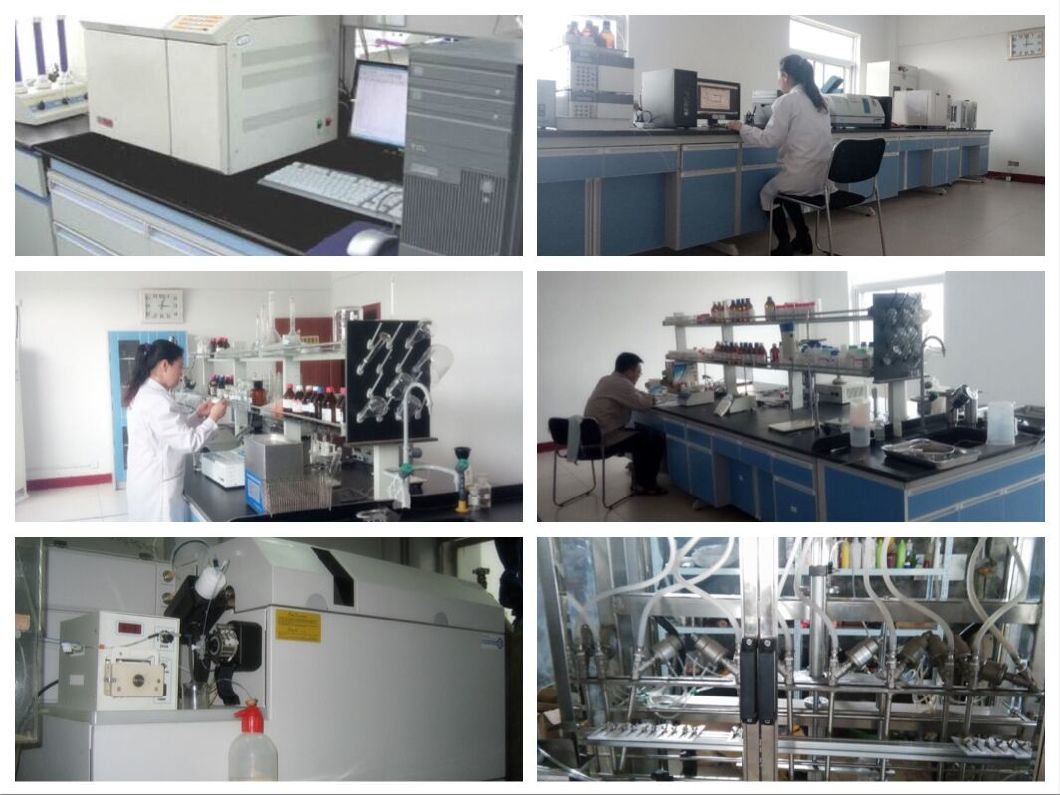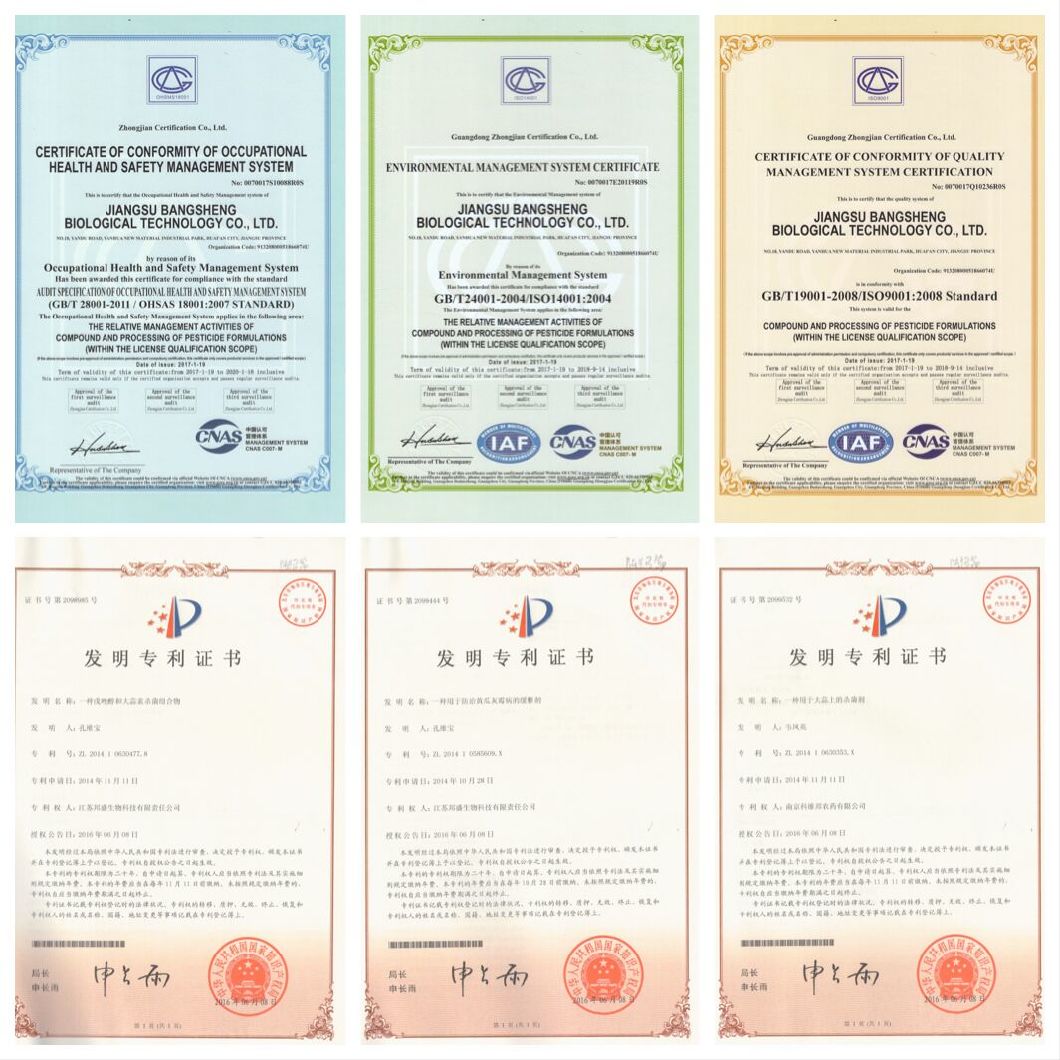Model NO.: SC SL EC WP Wg Wdg
Trademark: Cribon
Specification: 100g, 250g, 500g, 1kg, 10kg, 25kg, 200kg per bag/d
Origin: China
Model NO.: SC SL EC WP Wg Wdg
Trademark: Cribon
Specification: 100g, 250g, 500g, 1kg, 10kg, 25kg, 200kg per bag/d
Origin: China
Product DescriptionAppearance: Off-white powder
Specifications
Common name: Diflufenican
Other Name: N-(2, 4-difluorophenyl)-2-(3-(trifluoromethyl) phenoxy)-3-pyridinecarboxamide
CAS No.: 83164-33-4
Molecular formula: C12H4Cl2F6N4OS
Specification: 50%WP, 50%WDG, 41%SC
Physical & Chemical PropertiesÂ
Form: Colourless crystals.Â
B. P.: V. P.: 4.25 × 10-3 MPa (25 ° C, gas saturation method) Henry: 0.033 PA m3 mol-1S. G.Â
Solubility: In water <0.05 mg/l (25 ° C). Soluble in most organic solvents, e. G. Acetone, dimethylformamide 100, acetophenone, cyclohexanone 50, isophorone 35, xylene 20, cyclohexane, 2-ethoxyethanol, kerosene <10 (all in g/kg, 20 ° C).Â
Stability: Stable in air up to melting point. At 22 ° C, very stable in aqueous solution at pH 5, 7 and 9.Â
Fairly stable to photolysis.Â
ToxicityÂ
Oral: Acute oral LD50 for rats >2000, mice >1000, rabbits >5000 mg/kg.Â
Skin and eye: Acute percutaneous LD50 for rats >2000 mg/kg.Â
Non-irritating to skin and eyes (rabbits)
Inhalation: LC50 (4 h) for rats >2.34 mg/l air.Â
ApplicationÂ
Biochemistry: Carotenoid synthesis (phytoene desaturase) & photosynthetic electron flow inhibitor. Mode of action: Selective contact and residual herbicide, absorbed principally by the shoots of germinating seedlings, with limited translocation. Uses: Applied at 125-250 g/ha pre- or early post-emergence in autumn-sown wheat and barley to control grass and broad-leaved weeds, particularly Galium, Veronica and Viola spp. Normally used in combination with isoproturon or other cereal herbicides. Phytotoxicity: Any slight phytotoxicity is in the form of small transient patches on basal leaves, with no adverse effect on crop development.
Common name: Diflufenican
Other Name: N-(2, 4-difluorophenyl)-2-(3-(trifluoromethyl) phenoxy)-3-pyridinecarboxamide
CAS No.: 83164-33-4
Molecular formula: C12H4Cl2F6N4OS
Specification: 50%WP, 50%WDG, 41%SC
Physical & Chemical PropertiesÂ
Form: Colourless crystals.Â
B. P.: V. P.: 4.25 × 10-3 MPa (25 ° C, gas saturation method) Henry: 0.033 PA m3 mol-1S. G.Â
Solubility: In water <0.05 mg/l (25 ° C). Soluble in most organic solvents, e. G. Acetone, dimethylformamide 100, acetophenone, cyclohexanone 50, isophorone 35, xylene 20, cyclohexane, 2-ethoxyethanol, kerosene <10 (all in g/kg, 20 ° C).Â
Stability: Stable in air up to melting point. At 22 ° C, very stable in aqueous solution at pH 5, 7 and 9.Â
Fairly stable to photolysis.Â
ToxicityÂ
Oral: Acute oral LD50 for rats >2000, mice >1000, rabbits >5000 mg/kg.Â
Skin and eye: Acute percutaneous LD50 for rats >2000 mg/kg.Â
Non-irritating to skin and eyes (rabbits)
Inhalation: LC50 (4 h) for rats >2.34 mg/l air.Â
ApplicationÂ
Biochemistry: Carotenoid synthesis (phytoene desaturase) & photosynthetic electron flow inhibitor. Mode of action: Selective contact and residual herbicide, absorbed principally by the shoots of germinating seedlings, with limited translocation. Uses: Applied at 125-250 g/ha pre- or early post-emergence in autumn-sown wheat and barley to control grass and broad-leaved weeds, particularly Galium, Veronica and Viola spp. Normally used in combination with isoproturon or other cereal herbicides. Phytotoxicity: Any slight phytotoxicity is in the form of small transient patches on basal leaves, with no adverse effect on crop development.
Â
Our Factory of Nanjing CribonÂ

R&D Laboratory of Nanjing CribonÂ

Customize your Package

Certification of Nanjing Cribon

 Product Description
Appearance: Off-white powder
Specifications
Common name: Diflufenican
Other Name: N-(2, 4-difluorophenyl)-2-(3-(trifluoromethyl) phenoxy)-3-pyridinecarboxamide
CAS No.: 83164-33-4
Molecular formula: C12H4Cl2F6N4OS
Specification: 50%WP, 50%WDG, 41%SC
Physical & Chemical PropertiesÂ
Form: Colourless crystals.Â
B. P.: V. P.: 4.25 × 10-3 MPa (25 ° C, gas saturation method) Henry: 0.033 PA m3 mol-1S. G.Â
Solubility: In water <0.05 mg/l (25 ° C). Soluble in most organic solvents, e. G. Acetone, dimethylformamide 100, acetophenone, cyclohexanone 50, isophorone 35, xylene 20, cyclohexane, 2-ethoxyethanol, kerosene <10 (all in g/kg, 20 ° C).Â
Stability: Stable in air up to melting point. At 22 ° C, very stable in aqueous solution at pH 5, 7 and 9.Â
Fairly stable to photolysis.Â
ToxicityÂ
Oral: Acute oral LD50 for rats >2000, mice >1000, rabbits >5000 mg/kg.Â
Skin and eye: Acute percutaneous LD50 for rats >2000 mg/kg.Â
Non-irritating to skin and eyes (rabbits)
Inhalation: LC50 (4 h) for rats >2.34 mg/l air.Â
ApplicationÂ
Biochemistry: Carotenoid synthesis (phytoene desaturase) & photosynthetic electron flow inhibitor. Mode of action: Selective contact and residual herbicide, absorbed principally by the shoots of germinating seedlings, with limited translocation. Uses: Applied at 125-250 g/ha pre- or early post-emergence in autumn-sown wheat and barley to control grass and broad-leaved weeds, particularly Galium, Veronica and Viola spp. Normally used in combination with isoproturon or other cereal herbicides. Phytotoxicity: Any slight phytotoxicity is in the form of small transient patches on basal leaves, with no adverse effect on crop development.
Common name: Diflufenican
Other Name: N-(2, 4-difluorophenyl)-2-(3-(trifluoromethyl) phenoxy)-3-pyridinecarboxamide
CAS No.: 83164-33-4
Molecular formula: C12H4Cl2F6N4OS
Specification: 50%WP, 50%WDG, 41%SC
Physical & Chemical PropertiesÂ
Form: Colourless crystals.Â
B. P.: V. P.: 4.25 × 10-3 MPa (25 ° C, gas saturation method) Henry: 0.033 PA m3 mol-1S. G.Â
Solubility: In water <0.05 mg/l (25 ° C). Soluble in most organic solvents, e. G. Acetone, dimethylformamide 100, acetophenone, cyclohexanone 50, isophorone 35, xylene 20, cyclohexane, 2-ethoxyethanol, kerosene <10 (all in g/kg, 20 ° C).Â
Stability: Stable in air up to melting point. At 22 ° C, very stable in aqueous solution at pH 5, 7 and 9.Â
Fairly stable to photolysis.Â
ToxicityÂ
Oral: Acute oral LD50 for rats >2000, mice >1000, rabbits >5000 mg/kg.Â
Skin and eye: Acute percutaneous LD50 for rats >2000 mg/kg.Â
Non-irritating to skin and eyes (rabbits)
Inhalation: LC50 (4 h) for rats >2.34 mg/l air.Â
ApplicationÂ
Biochemistry: Carotenoid synthesis (phytoene desaturase) & photosynthetic electron flow inhibitor. Mode of action: Selective contact and residual herbicide, absorbed principally by the shoots of germinating seedlings, with limited translocation. Uses: Applied at 125-250 g/ha pre- or early post-emergence in autumn-sown wheat and barley to control grass and broad-leaved weeds, particularly Galium, Veronica and Viola spp. Normally used in combination with isoproturon or other cereal herbicides. Phytotoxicity: Any slight phytotoxicity is in the form of small transient patches on basal leaves, with no adverse effect on crop development.
Â
Our Factory of Nanjing CribonÂ

R&D Laboratory of Nanjing CribonÂ

Customize your Package

Certification of Nanjing Cribon

Â
Cheap Price Endoscope Camera,3mm Industrial Endoscope,Portable Video Endoscope,Video Snake Endoscope Borescope Camera
Screen Video Borescope, Vedio Inpection Camera Co., Ltd. , http://www.nbborescope.com